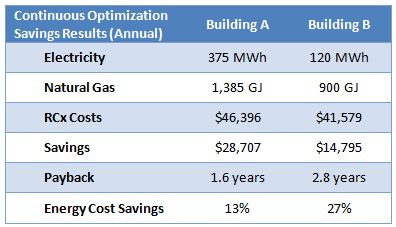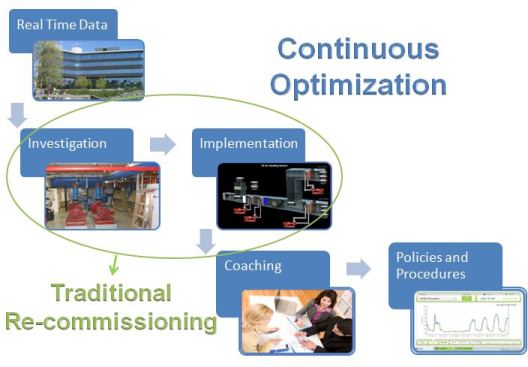Getting the Most out of Your Building Automation System

|
April 2012 |
[an error occurred while processing this directive] |
|
Continuous Optimization
Getting the Most out of Your Building Automation System |
 |
| Articles |
| Interviews |
| Releases |
| New Products |
| Reviews |
| [an error occurred while processing this directive] |
| Editorial |
| Events |
| Sponsors |
| Site Search |
| Newsletters |
| [an error occurred while processing this directive] |
| Archives |
| Past Issues |
| Home |
| Editors |
| eDucation |
| [an error occurred while processing this directive] |
| Training |
| Links |
| Software |
| Subscribe |
| [an error occurred while processing this directive] |
Let’s
say you have a well managed, well maintained, relatively efficient
building. Someone offers you the chance to reduce your energy use by at
least 10%, improve tenant comfort, and install new controls features -
all with a payback of 2 to 3 years. Intrigued? Skeptical? These
are the results for more than 50 of SES Consulting’s Continuous Optimization clients this year.
Why Continuous?
Anyone with experience in building automation knows that, from time to
time, your system needs a tune up. Building performance declines over
time and, as a consequence, energy use increases. Poor performance can
be the result of deficiencies in the original commissioning, broken or
miscalibrated sensors, conflicting set points, or manually overridden
equipment to name a few common problems.
The standard response to these issues is to embark on a
retro-commissioning (RCx) of building systems; identifying and fixing
all the issues that have arisen over time. Although RCx can be very
effective at reducing energy consumption in a building, the persistence
of savings can be poor. In a few years you’re likely to find many of
the same problems and poor performance that existed before. Breaking
out of this cycle is the motivation for Continuous Optimization.
Continuous Optimization addresses the shortfalls in the RCx process by
incorporating real time feedback on building performance that alerts
staff when building performance starts to slip. Enabling your
operations team to identify and correct the problem when it occurs and
maintain optimal building operation. The following table shows the
results of two recent Continuous Optimization projects
in British Columbia.

Although the savings and payback are impressive, more important is the
fact that more than a year later these savings are being maintained
and even improved on, using a Continuous Optimization approach.
Finding the Savings – The Responsive Building
Beyond the energy savings from returning systems to their original
operating condition, there are often extensive opportunities to improve
operations efficiency when compared with the original design.
Installing new controls technologies or using strategies that weren’t
available or cost effective at the time of the original build, can lead
to even greater savings. The rapid development of new controls
technology combined with falling prices for many of these items has
made these controls accessible for a relatively small investment. The
table below shows a sampling of some common measures that can be
implemented as part of a Continuous Optimization process.
Typical Control System Enhancements
The common purpose of these measures is to allow the building to
respond better to variable loads. The environment in which a building
operates is always changing; people come and go, weather changes and
daylight levels go up and down. Older buildings tend to maintain their
systems operating at constant loads usually designed for maximum
occupancy, unable to take advantage of the changing loads to make the
building more responsive, comfortable, and save energy. With the
addition of new control strategies and devices such as variable speed
drives and sensors to measure air quality or detect occupancy, we can
use the existing BAS infrastructure to respond and meet changing
conditions, significantly reducing the energy footprint of the
building.
The Continuous Optimization Process

Continuous Optimization starts with collecting real time data on the
building operations. This information can be collected using the
building’s BAS or by software monitoring real time energy consumption.
This software, often cloud based, is known as an Energy Management
Information System or EMIS. The real-time data is used to better
understand the operation of the building so that a performance baseline
can be established. The baseline is then used to verify the energy
savings once the building has been optimized.
During investigation, the energy conservation opportunities and
operational deficiencies are identified from a combination of on-site
investigation and review of the BAS and EMIS. Real-time energy
data can reveal important information about the building that is not
obvious from monthly energy bills. As an example, high overnight
base loads or unusual demand spikes, readily visible in real-time data,
may indicate load scheduling and demand shifting opportunities. Once
the opportunities are identified, a list of potential measures is
developed, and the most cost effective or desirable of these are then
selected for implementation. The measures are implemented by a team
including the consultant, contractors, and building operations staff.
During implementation the EMIS provides valuable feedback on the
effectiveness of each measure, allowing your team to make adjustments
and ensure the maximum energy savings potential is achieved.
Maintaining those hard earned energy savings is the heart of what
differentiates Continuous Optimization from a standard RCx approach.
This is often the component that presents the greatest challenge for
many facilities. One or two set point changes that go unnoticed can
dramatically erode energy savings. Training your operations staff to
understand the measures implemented, identify when they have varied
from optimal, and respond to these exceptions in real-time is critical.
In the past, most building operations staffs have been focused on
keeping people comfortable. With a Continuous Optimization program,
they are also the ones with the best opportunity to maintain energy
savings. We’ve found the following tools and supports are crucial
for success in this undertaking:
[an error occurred while processing this directive]
Saving energy doesn’t have to end at the mechanical room. Many of the
Continuous Optimization tools can also allow you to communicate this
success to the building occupants and administration. Energy display
dashboards in public areas or allowing web access to a virtual
dashboard can be a great way to gain the support of building occupants.
Real-time feedback on staff-led initiatives such as turning down the
temperature or turning off lights has proven to be an asset in
motivating occupants. People are much more willing to go the extra mile
when they know that their actions are making a difference.
Going Beyond – The Future of Continuous Optimization
The measures and projects described above can largely be accomplished using 15 year old BAS technology. However, BAS are currently undergoing a rapid evolution incorporating more modern technology and harnessing the power of the web and cloud. The BAS is no longer just a tool to operate mechanical equipment, but a system that gathers information from numerous sources (temperature, weather, air quality, energy use, occupancy sensors, light levels, etc) and uses this information to operate the building in the most efficient manner possible. With more advanced capabilities, BAS technology is becoming increasingly integrated, sharing data between formerly disparate systems such as HVAC, security and lighting. This allows the system to make better decisions, avoid duplication of equipment and automate more of a building's operations. Most if not all of these advanced features can be justified in the name of energy efficiency, improved comfort, or better maintenance.
Modern BAS systems are creating new information streams like analytics
or fault detection and diagnostics (FDD). Analytics expands on the EMIS
described earlier; using information mined from the BAS to
automatically alert staff to abnormal or unusual equipment behavior
caused by broken valves, sensors out of calibration, failed
controllers, etc, before they cause problems. This can greatly speed up
the process of identifying and diagnosing operational problems,
improving maintenance of various building systems, and preventing
catastrophic failures.
The web based nature of the modern BAS also makes it easy to broadcast
building related information to occupants. Below is an example of a
dashboard display that combines live energy consumption data with data
feeds from elsewhere on the web, in this case showing sports and
weather information to draw more traffic.
Occupant Information Dashboard (Courtesy of ESC Automation)
Intelligent buildings allow us to go further than ever before in
achieving improved efficiency and performance in a practical and cost
effective manner. Below are just some of the advanced energy savings
features being implemented in several SES Consulting
projects.
Advanced Control System Enhancements
An advanced, integrated, BAS allows you to turn off ALL lights and
non-critical plug loads in a building when the security system or space
occupancy sensors indicate the building is empty. Intelligent
occupancy sensors and advanced algorithms can not only tell you if
someone is present, but how many people, and automatically adjust the
lighting and HVAC system appropriately. SES has used this strategy with
great success in intermittently used spaces such as university lecture
theaters to avoid bringing on all of the lights and HVAC systems if the
space is only being used by one student. These represent a small
sampling of the opportunities to customize advanced control systems to
meet the unique needs of your facility.
Taken together, these features make it possible to operate buildings
smarter and more efficiently, making a powerful business case to
upgrade to a modern, state of the art, control system. More
importantly, the web enabled interfaces and cloud based services
facilitate the sharing of key performance information throughout your
organization, from occupants, to operations, to executives at the
enterprise level.
The opportunities to automate and improve building operations will continue to grow and evolve. Continuous optimization, whether you have a 15 year-old BAS or a fully integrated modern system, will allow you to take full advantage of these systems, achieving and maintaining optimal building operations throughout the life of your building.
About the Author
Brad
White, P.Eng, MASc, Principal - Brad has four years of experience
working with energy systems as a researcher and mechanical engineer.
His work has focused on seeking ways to improve the sustainable use of
energy through conservation and improved efficiency. Prior to joining
SES Consulting Inc., Brad helped develop new manufacturing techniques
for clean energy technologies as a master’s student and research
engineer at UBC.
[an error occurred while processing this directive]
[Click Banner To Learn More]
[Home Page] [The Automator] [About] [Subscribe ] [Contact Us]